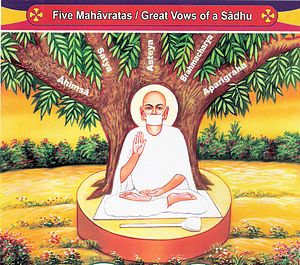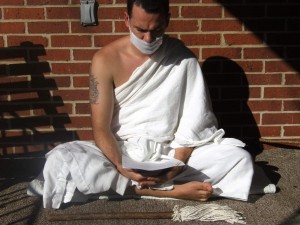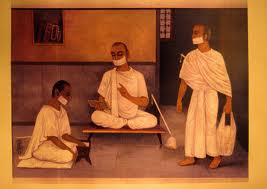Depending on your source, there are between 4 and 10 million Jains in the world, making it one of the smallest of the world’s religions. Out of those numbers, only a small fraction become Sadhus or Sadhvis (monks and nuns, respectively).
I’m beginning to understand why.
Mahavira, the 24th Tirthankara and founder of modern Jain philosophy, once said,
“The unenlightened takes millions of lives to extirpate the effects of karma whereas a man possessing spiritual knowledge and discipline obliterates them in a single moment.“
That spiritual knowledge and discipline comes from the monastic life of complete and total renunciation. Most of the Jain laity aspire to reach this level of commitment either in this life or one soon after, and it is for this reason that the lay community supports the monastic orders.
There are two main sects within the Jain philosophy: 1) Digambara (“sky-clad”) and 2) Svetambara (“white clad”). Within these two groups are many sub-sects, however there are little doctrinal differences between the major divisions of the Jain way. Separation comes from differences in rites and practices. For example the Digambara sects are “sky-clad,” meaning they’ve renounced even wearing clothing, as it displays attachment to earthly items and concepts/emotions such as shame. According to their philosophy, they wear the very atmosphere around them. The Svetambara or “white clad” sect wear simple white robes and also believe that women can achieve moksha (liberation). The Digambara do not believe this because of social restraints on women.
Within these groups are those who worship idols of the Tirthankaras with puja (worship rituals) and reform movements which reject the use of or worship of idols. All groups observe ahimsa (non-violence) as the most important part of their philosophy.
Each group takes a specific vow of behavior and renunciation. Some sects add to this list. In general, the vows go as follows:
Absolute non-violence
Absolute truthfulness
Absolute non-stealing
Absolute celibacy
Absolute non-attachment

(All Jains, including the laity, strive for these vows to some degree. Only the monks and nuns follow them completely).
In addition, we have the Gupti (Three Restraints) and the Samiti (Five Carefulness)
Gupti:
Control of mind
Control of speech
Control of body
Samiti:
Carefulness while walking
Carefulness while communicating
Carefulness while eating
Carefulness while handling whisks, water gourds, etc
Carefulness while excreting waste
Again, for the monks/nuns and laity both, all of these principles center on ahimsa (non-injury). All must take care in everything they do, for even a harmful thought toward another–regardless of the species–is considered violence.
So, what was my first full day like living as a Jain monk? Hard. Just to be clear, I chose to live this way for November for two reasons: 1) I wanted to explore the extremes of religious practice (monasticism). 2) Because the Buddhist and Jain laity are very similar, the difference between my experience in May and November would be very little. Otherwise, I only get one chance to do this. Just one year. I want to make the most of this experience.
A Jain monk’s life is centered around his or her progress toward moksha and so there is little time or room for anything else. With this in mind, Sadhus and Sadhvis spend their time teaching Dharma (the faith) to the laity, or in meditation/study of the Jain path. Project Conversion is my opportunity to both learn and teach. I do this at the beginning of the day, sitting on the floor in my robes while writing a post.
Other than that, I meditate on the “12 Contemplations” (Bhavanas) which include impermanence, the universe, and protection. In addition, I study Jain philosophy through the Agams, or scriptures.

In the tradition of the Digambara sect, I only take food once a day (around noon), and only what I can fit in my cupped hands. Traditionally, monks visit many homes of the laity and only take a small amount of food from each. I don’t exactly have a lot of Jain laity to visit in my town, so my wife and kids fill the role.

Different sects have various rules here, but for the most part, Jain monks and nuns do not stay in one location for more than a few days. Many monks will spend the night in temples where they teach, only to pick up the next day and walk barefoot to the next. Others (especially the sects which do not have temples for the idols) stay in special buildings called sthanakas or “meditation halls.” A few spend the evening in special additions made to the homes of the laity.
The idea here is non-attachment. This includes attachment to comforts and our surroundings. I don’t have random places to stay, so to honor this tradition, I sleep on the floor in various parts of my house.

I lasted until about 2 a.m. After that, I set my butt on the couch. I will try for longer periods each night until I either lose my mind or overcome the discomfort.
This is the way I’ve chosen to live this month. Not everyone agrees with it but it’s a way of life many hold dear. This isn’t about “Look at me! Look at me!” it’s all about “Look at this! Look at this!” November is the only month I’ve chosen to observe a monastic lifestyle (as closely as I can) because I think it nicely rounds out the religious experience this year. We don’t have to agree with the practices of others to learn from them.
What are your thoughts on the monastic life (regardless of religion)? Do you have any experience as a monk or nun? Do you have family members who are part of this life?

